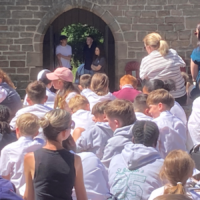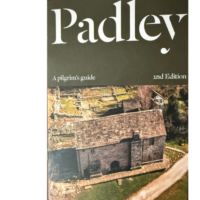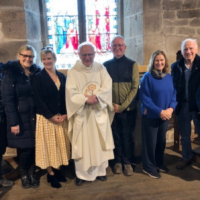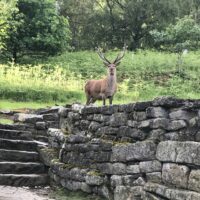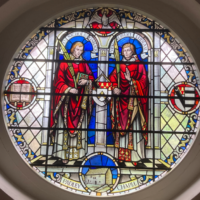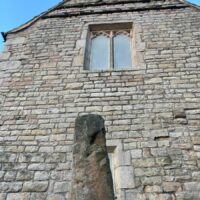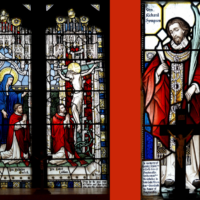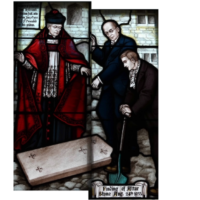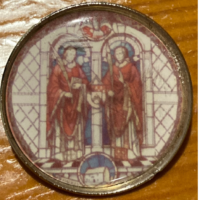HISTORIC CHURCHES
Welcome to Padley Chapel
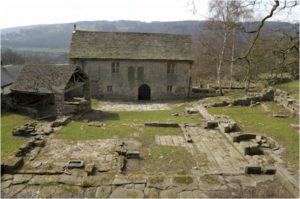 A Turbulent History
A Turbulent History
The story of Padley is written in its stones. An altar stone hidden for three and a half centuries, the hearth stones, steps and foundations of a fine medieval manor – these are the building blocks of Padley's tale. Together they rise into a tragic story of persecution, betrayal, martyrdom and the fall of a wealthy recusant family and of Padley's rebirth as a centre of worship and pilgrimage.
As fears of a Spanish Catholic invasion grew, persecution of recusants (people who refused to recognise the Queen's supreme religious authority in England) was increasing. In the early morning of 12 July 1588, Padley Manor, the residence of the recusant John Fitzherbert was raided. Two travelling priests – Nicholas Garlick and Robert Ludlam – were staying overnight. The priests and everyone else in the Hall were arrested. Garlick and Ludlam along with another priest Richard Simpson, were brutally executed in Derby a fortnight later.
An annual Pilgrimage to Padley in honour of the martyrs began in 1898 - see Pilgrimages tab. In 1931 Mgr. Charles Payne of the Diocese of Nottingham bought the property and restored the building which , due to boundary changes, is now owned by the Diocese of Hallam. In 1934 the altar stone, which had been hidden by the Fitzherbert family shortly before their arrest was discovered buried in the garden. It was restored to its rightful place in what would have been the domestic chapel of the house and to its rightful place in a story of constancy and of those who bravely kept the light of their faith burning through the dark centuries.
A brief history of Padley Martyrs' Chapel and Manor
The building is known by a variety of names – Padley Manor, Padley Hall, Manor Gatehouse, Padley Chapel - it has been known by all of these names throughout its history. It is certain that the Manor of Padley was on this site before the Norman Conquest but we have no written evidence. However, the Manor and its lands were given to the de Bernac family, followers of William the Conqueror for services rendered. It was normal for these families to change their names to the place they had been given and so the family name became Padley. There is evidence that they built, probably onto an existing hall house and improved the manor in the fashion of the time. The ruins to the west of the site are evidence of this.
The Padley family lived and prospered here for about 350 years during which time they developed the site with a medieval manor house built onto the existing building in about 1350. At some time during the early years of the 15th century the male line failed leaving a surviving daughter, Joan, as sole heiress. She married Robert Eyre and they made Padley their home. The family continued to prosper and they completed the manor house and added a fine Gatehouse, the status symbol of the day. Robert died in 1459 and Joan in 1468.
Four generations of the Eyre family lived here but again a daughter, Anne, inherited. She married Sir Thomas Fitzherbert of Norbury in 1534. He assigned Padley to his younger brother John. The Fitzherberts were staunchly recusant and Thomas spent the years 1559 – 1591 in prison because of early Elizabethan Religious Settlements, refusing to conform to the Anglican Church. He died in prison as did his brother John in 1590.
Padley had become a safe haven for missionary Catholic priests who bravely continued their ministry in the land, seeking refuge where they could but knowing that capture would result in death. In 1587 the execution of Mary, Queen of Scots and the threat of a Catholic Spanish invasion in 1588 stirred up considerable anti Catholic suspicions. Up to this time, although considerably deprived in many areas of their lives (as a Catholic it was not permitted to hold any public or professional office or gain a degree from a university, or be a member of the army etc) it had been possible to continue their lives quietly, paying their fines for non-attendance at the church etc. However, things changed dramatically, new laws were passed making it a capital offence to harbour or assist a priest, the charge being High Treason. With the threat of invasion the government decreed that certain prominent Catholics should be arrested and imprisoned. A raid was carried out at Padley by George Talbot, the Earl of Shrewsbury, on 12th July 1588. Sadly, it coincided with a visit from not one but two priests, Nicholas Garlick and Robert Ludlam. This resulted in the whole family, including the servants being arrested and taken to Derby jail. The priests were tried and found guilty and executed near to Derby Bridge on 24th July 1588.
The manor was confiscated and passed through various hands before eventually returning to the family. The direct ownership died out in with William Fitzherbert of Swynnerton, a cousin, who inherited the property in 1649 but was forced to sell because of recusancy fines and heavy debts. It seems that Padley Manor was never lived in again: a subsequent owner pulled the house down and sold the stone as building material. The Gatehouse remained intact and was used as a cow shelter and hay barn.
The first Pilgrimage, in honour of the martyred priests was held amid the ruins in 1892, arranged by Father Phillip Fletcher, master of the Guild of Our Lady of Ransom. The Pilgrimages have continued ever since. In 1931 Mgr.Charles Payne, of the Diocese of Nottingham, was able to purchase the Gatehouse and a small amount of surrounding land. It was repaired and presented as we see it today and was consecrated as a Chapel. The Chapel, due to boundary changes, is now owned and administered by the Diocese of Hallam. Each year a guest speaker is invited to preach at the Pilgrimage Mass and this year (2010) we were privileged to welcome the Archbishop of Westminster, the Most Rev. Vincent Nichols which was a great honour for us.
Much damage was done to the building in 2006 when the roof was set alight following a lightening strike. Repairs are complete but English Heritage have taken an interest in the ruins outside the Chapel. A great deal of damage is caused to the ruins by visitors and the plan is to stabilise the stones and at the same time to investigate the site, both historically and archaeologically, in order to offer a true interpretation of the visual remains. It will be a great delight to have more to tell the many visitors who make their way to Padley each year to enjoy the very special charm and peace and tranquillity of this delightful solitary place as it was described by an owner many centuries ago.
The Padley Martyrs
Nicholas Garlick and Robert Ludlam were arrested at Padley Manor House, the home of John Fitzherbert, on 12th July 1588. They were taken to Derby Gaol where they were charged together as having come into England as Catholic Priests. We are told that Garlick spoke for Ludlam as well as for himself "being very bold, his answers did serve them both." They were convicted of treason on 23rd July 1588. We are told that the night before their execution they shared a cell with a fellow priest, Richard Simpson, and a woman convicted of murder. In the course of the night they were able to reconcile the woman to God, and on the scaffold the next day she openly professed her faith. They were executed on St Mary's Bridge at Derby on 24th July 1588.
There is a tradition that the two priests, Nicholas Garlick and Robert Ludlam, passed through the village of Eyam on their way to Derby. The following note occurs in the History of Antiquities of Eyam by William Wood:
The Catholic priests, Robert Ludlam of Whirlow and Nicholas Garlick of Glossop, taken prisoners at Padley Hall in the reign of Elizabeth, were, it is said, much reviled on passing through Eyam to Derby, when one or both made some remark which bigotry has construed into a prediction of the Plague.
The title Venerable was bestowed on the two martyrs when the process of their beatification commenced (exact date unknown) and they were beatified and the title Blessed conferred upon them on 22nd November 1987. It may be many years before they are declared to "have already entered into heavenly glory" and ordained as 'Saints'.
Born at Dinting near Glossop in North Derbyshire about 1555. It is known that he went to Oxford as a student of Gloucester Hall (now Worcester College) at the age of 20 in 1575. He spent no more that six months at the university, perhaps due to the fact that from 1559 all those taking a university degree were required to swear an oath of acknowledgement of the supremacy of the Queen (Elizabeth I) in religious matters. As a Catholic, Nicholas would have felt unable to take the oath. After leaving university he went to Tideswell in Derbyshire and there kept a free school. A pupil of Nicholas, Robert Bagshawe (who later became a monk and ended his life as president of the English Benedictines), said: "Nicholas Garlick discharged his duties so well that by the good and most charitable care [.....] as if they were his own children."
It was in the English College at Rheims that Nicholas began his studies for the priesthood on 22nd July 1581. He was ordained Priest at Chalons-sur-Marne at the end of March the following year (1582). He celebrated his First Mass on 7th April 1582 and less than a year later, January 1583, he left Rheims for England. Nicholas Garlick's movements in England in 1584 were followed by Thomas Dodwell, a former student at Rheims who had turned spy. Nicholas stayed during this time at the house of a Mr Waterton at Burford Bridge in Staffordshire but, upon hearing of the appearance of Thomas Dodwell in the area, Mr Waterton's family insisted that Nicholas leave. He was eventually arrested in London, imprisoned and then banished from the realm. He arrived back in Rheims on 17th October 1585 but, having spent only two days there, he returned to England. Very little is known of Nicholas Garlick's activities during the second period of his missionary work. He was in London in April 1586 and in September that same year "He was labouring with diligence in Hampshire and Dorsetshire." The spy who reported these activities expressed the hope that Nicholas would soon be caught. This hope was not to come to fruition for nearly two years. In March 1588 he was known to be working in Derbyshire and in July that year he was arrested, almost by accident, at Padley along with Robert Ludlam. Their execution took place 12 days later at Derby.Dr Charles Cox, 19th century author of The Churches of Derbyshire, recorded "that tradition says Nicholas Garlick's head has been buried in the Churchyard at Tideswell."
Born in the mid 16th century, according to one source at Whirlow, Sheffield, but according to another at Radbourne near Derby. He entered St John's College, Oxford in 1572. In November 1580 he entered the English College at Rheims and was ordained priest at Soissons on 21st September 1581. On 30th April 1582 he set out for England. Fr Robert Bagshawe states that Robert Ludlam "for his majesty and good life and zeal to win souls to God, was beloved of all that love the Catholic Church." Another contemporary source tells that "he was a mild man, did much good in the country, for that he did much travel and was well beloved."
Thanks to Barbara M Smith of Bamford on whose booklet 'The Padley Martyrs' this article has been based.
ArcHeritage Report on Padley

In mid 2010, The Diocese of Hallam appointed archaeological consultants ArcHeritage, part of the York Archaeological Trust, to carry out site surveying, recording and a condition assessment at Padley Hall and Martyrs’ Chapel. The site is a Scheduled Ancient Monument and the Chapel itself is a Grade 1 listed building. Padley Hall was excavated in the 1930’s and its partially consolidated remains have been suffering from accelerating decay and damage caused by a number of factors. The on-site work and subsequent analysis has been supplemented by archival research and interpretation.
ArcHeritage submitted their report - a Conservation Management Plan - in March 2011 for consideration by the Diocesan Trustees.
Part One of their report - Background Information, Surveys and Assessment of Significance - is available to read here. The figures referenced in the text are available to read here. [The documents are 'read-only' PDF files]. The photographic plates can be viewed in the Gallery. [NB Plate 4 in the report is copyright protected and cannot be reproduced on this website].https://hallam-diocese.com/milanesa/uploads/2015/06/ArcHeritage_figures1_24_web.pdf
The intellectual property rights of the entire content of the report are retained by ArcHeritage and the report is copyright to the Diocese of Hallam and ArcHeritage 2011. ArcHeritage are the acknowledge authors of the material contained in the report. All rights reserved - no content of the report can be copied, printed or reproduced in any format (including electronic or web-based) without the written permission of the Diocese of Hallam and ArcHeritage. If you wish to copy, print or reproduce any on the content please contact the Diocesan Property Department on [email protected] or 0114 256 6420.
Visiting Padley Chapel
Opening Dates 2024: The Chapel will be open on Sundays, 2:00pm to 4:00pm, from 31 March - 13 October.
Travelling to Padley Chapel
Pilgrimages to and latest news from Padley
Pope Francis called us to be ‘Pilgrims of Hope’ in this Year of Jubilee 2025 and undertake physical and spiritual pilgrimages to strengthen our faith and cultivate hope, in a challenging… Father Garett Sweeney (1912-1979) was born in Derby and ordained in the Diocese of Nottingham in 1937. In 1964, after a varied academic and parish career, he was elected Master… 31st March to 30th September, 2024 Padley Chapel is a 14th century chapel and gatehouse forming part of Padley Manor, the remaining ruins of which lie adjacent to the chapel…. On Saturday 20 April 2024 a retired priest, Father Michael McGourty from Co. Fermanagh, celebrated Holy Mass in Padley Chapel. For many years he has visited Walsingham in honour of our… A reflection by ‘Friend of Padley Volunteer’ Anne-Marie Fletcher Have you noticed an emerging interest, within the culture, for walking ancient pilgrimage routes, through beautiful countryside? Enjoying Creation with outdoor… ‘The Three Altars’ Way’ A small group of Pilgrims, walked a ‘trial’, ‘Three Altars Way’ pilgrimage in Easter Week 2024. The Catholic, ‘Hearts in Search of God’, pilgrimage project, was… The Padley Chapel ‘standing stone’ Well it’s a stone and it’s standing. Beyond that, there isn’t any certainty about the origins and purpose of this stone.Early photographs of Padley Chapel… The Blesseds’ Padley Chapel Windows Three of Padley Chapel’s stained glass windows, depict the Bl Nicholas Garlick, Bl Robert Ludlam and Bl Richard Simpson, who as Missionary Priests, in Elizabethan… ‘Padley – its Martyrs and Restoration 1588-1933’. There’s no author’s name on this little red booklet, but it’s clearly the work of Mgr Charles Payne V.G.(Nottingham Diocese), who was the… We shouldn’t ignore the possibility of a ‘touch of grace’, from the Holy Spirit, in our lives. Something that our ongoing Synodal journey is reminding us all of. Decide for…Padley Chapel’s ‘Pilgrims of Hope’ 2025
A Pilgrim’s Guide to Padley by Garett Sweeney 2nd Edition
Report on Visitor Activity to Padley Chapel
From Ireland to Padley
Pope – Pilgrimages – Padley
Walking the Hathersage Pilgrim Ways – April
Walking the Padley Pilgrim Ways March
Walking the Hathersage Pilgrim Ways
Walking the Hathersage Pilgrim Ways
‘The Padley Martyrs’ Way’ – a Pilgrim Valley of Hope.


